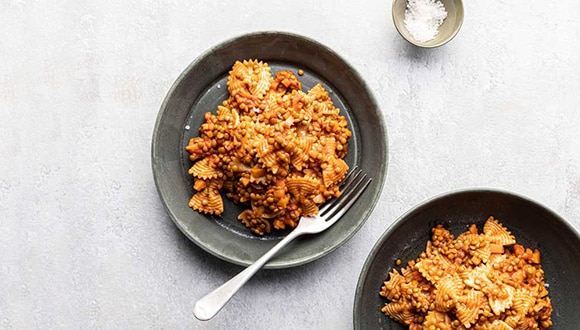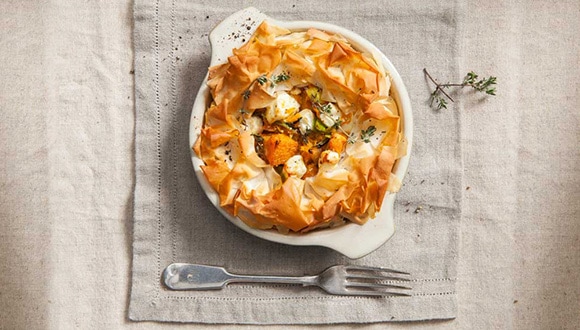Three recipes that could help you live longer
Published June 2024 | 4 min read
Expert contributor Professor Luigi Fontana, director of the Healthy Longevity Research and Clinical Program at the Charles Perkins Centre
Words by Lucy E Cousins
These three easy recipes combine essential vitamins and nutrients to help you live a longer, healthier life.
With average life expectancy in Australia currently sitting at 84.06 years, it’s estimated that by 2026 more than 22% of Australians will be aged over 65. Staying active and healthy throughout our later years has, not surprisingly, become more of a focal point for many Australians.
The key to a longer health span (the period of your life when you are healthy — not just alive), says Professor Luigi Fontana, director of the Healthy Longevity Research and Clinical Program at the Charles Perkins Centre, is to regularly consume food that harnesses the power of nutrition to “promote longevity and vitality”.
In his new book, Manual of Healthy Longevity & Wellbeing, Prof Fontana looks at how the food you eat can affect how long you live and the state of your health as you age – something that he says most people incorrectly associate with simply losing weight.
“The pursuit of successful ageing and healthy longevity extends far beyond weight loss,” he explains. “Losing weight doesn't always equate to metabolic benefits and can even have negative health implications. My aim is to shift the focus away from weight-centric diets towards embracing a holistic and sustainable lifestyle.” And that involves a range of lifestyle factors – including a balanced diet – to achieve optimal health, says Prof Fontana.
“It involves a holistic approach that includes exercise, adequate sleep and cognitive-emotional training [learning to cope with your emotions, reduce stress and anxiety],” he says.
Eligible HCF members can access a range of evidenced-based online mental health services as part of our commitment to Uncommon Care to help manage feelings of anxiety, stress, insomnia and depression*.
In terms of nutrition, Prof Fontana’s advice is to adopt a “moderately kilojoule-restricted diet with optimal nutrient intake”. A good example of this is the Mediterranean diet, which emphasises plant-based foods like vegetables, fruits, legumes and whole grains, along with fish and seafood and limited red meat.
A recent study confirmed that this way of eating – together with moderate levels of exercise – has been linked to improved heart health, as well as lower instances of obesity and obesity-related cancers.
Eating for longevity
So, what should you be eating to promote a long and healthy life? Prof Fontana offers the following five tips.
- Reduce the number of ‘empty’ kilojoules in your diet (food with little or no nutritional value, like soft drinks and fast food).
- Consume a primarily plant-based, fibre-rich diet with fish and low-fat dairy products.
- Limit your intake of saturated and trans fatty acids (often found in highly processed food, like frozen dinners, pretzels and chips, sweets and some dressings and sauces).
- Increase fibre, polyunsaturated omega-3 fatty acids and essential vitamins (fish, seeds, nuts, legumes, fruit, vegetables and low-sugar cereals).
- Cut back on alcohol. Drinking alcohol, even in small quantities, can increase your risk of cancer and other health conditions
Farfalle Pasta with Lentil Ragout
“This pasta combines the complex carbohydrates of farfalle pasta with the plant-based protein and fibre of lentils, creating a balanced and filling dish,” explains Prof Fontana.
“Lentils are also rich in folate, iron and other essential nutrients, contributing to overall health and energy levels.”

Prep time: 20 minutes
Cooking time: 30 minutes
Serves 4
Ingredients
- 80ml extra virgin olive oil
- 1 garlic clove, finely chopped
- 2 tbsp finely chopped celery
- ½ onion, finely chopped
- pinch of chilli powder
- 2 pinches of salt
- 2 carrots, chopped
- 2 tbsp freshly squeezed lemon juice
- 300g red lentils, rinsed
- 700g tomato passata (puréed tomatoes)
- 320g farfalle pasta
- freshly ground black pepper
Method
- Heat the olive oil in a non-stick frying pan over a medium heat and add the garlic, celery, onion, chilli powder and a pinch of salt. Stir for 1 minute. Add the chopped carrots and lemon juice, and keep stirring until the carrots soften.
- Add the lentils (they do not need to be soaked), passata and 750ml water. Stir and raise the heat slightly, then cook for about 20 minutes or until the lentils are tender.
- Fill a large saucepan with water and bring it to the boil. Add the farfalle to the boiling water with a pinch of salt and cook according to packet instructions until al dente (usually about 10 minutes).
- Drain the pasta, reserving a little of the cooking water, then add to the pan with the lentils and some freshly ground black pepper. Mix well – if it’s a little dry, add some of the reserved cooking water. Serve immediately.
Roasted Tomato and Red Capsicum Soup
“This soup is packed with the antioxidant power of tomatoes and red capsicums, which are excellent sources of vitamins A and C,” explains Prof Fontana. “These nutrients help support immune function and promote healthy skin and vision.”

Prep time: 20 minutes
Cooking time: 1 hour 20 minutes
Serves 4
Ingredients
- 800g tomatoes, halved
- 2 red capsicums
- 1 tsp extra virgin olive oil
- 1 onion, chopped
- 1 tsp smoked paprika
- 1 potato, chopped
- 750ml vegetable stock
- parsley, to serve
- 4 tsp low-fat Greek-style yoghurt, to serve (optional)
Method
- Preheat the oven to 220°C. Place the tomatoes and capsicum on a baking tray and bake for 30 minutes, or until the capsicum skins are wrinkled and the tomatoes have collapsed.
- Place the capsicums in a paper bag and leave to cool completely. Set the tomatoes aside to cool. Peel and discard the skins from both the tomatoes and capsicums. Also discard the capsicum seeds.
- Heat the oil in a large saucepan over a medium heat. Cook the onion for 5 minutes, stirring occasionally, until soft. Add the paprika and stir for 1 minute, until fragrant. Add the roasted tomatoes and capsicums to the pan with the potato and stock, and bring to the boil. Reduce the heat to low and simmer for 30 minutes. Purée with a blender.
- Reheat gently over a low heat. Ladle into bowls and top each with parsley and a teaspoon of yoghurt if desired.
Baked Pumpkin and Feta Filo Pie
“This dish provides a hearty serving of pumpkin, which is rich in vitamins, minerals and antioxidants like beta-carotene,” explains Prof Fontana. “Combined with healthy proteins from feta cheese and the goodness of filo pastry, it offers a satisfying and nutrient-dense meal. The use of olive oil adds heart-healthy fats, making this pie a wholesome option for promoting cardiovascular health.”

Prep time: 10 minutes
Cooking time: 1 hour 10 minutes
Serves 4
Ingredients
- 500g butternut pumpkin, peel removed
- 2 tbsp olive oil
- 1 onion, finely chopped
- 3 sprigs rosemary, finely chopped
- 4 free-range eggs
- salt and freshly ground black pepper
- 8 sheets filo pastry
- 120g feta cheese, or diced mozzarella cheese
- green salad, to serve
Method
- Preheat the oven to 180°C. Coarsely chop the pumpkin into chunks of about 2.5cm and place in a baking dish. Bake for about 30 minutes or until the pumpkin is cooked. Set aside to cool. Leave the oven on.
- In the meantime, heat a frying pan over a medium heat, add 1 tbsp of olive oil and sauté the onion until softened and beginning to brown. Remove from the heat and place into a large bowl to cool. When cool, add the rosemary and mix in the cooled pumpkin.
- In another bowl, beat the eggs well. Season with salt and pepper.
- Layer the filo in a 23cm round pie dish, basting lightly with the remaining olive oil. Leave some of each sheet of filo hanging over the edge of the pie dish by about 10cm (this will be folded back over the pie when the dish is filled). Add the cooled vegetables to the filo-lined pie dish. Pour in the egg and crumble over the feta or mozzarella cheese. Fold the edges of the filo over the pie – they don’t need to completely cover the dish.
- Bake for 40 minutes until nicely browned and the middle has set. Serve slices with a green salad.
This is an edited extract from Manual of Healthy Longevity & Wellbeing by Luigi Fontana, published by Hardie Grant Books. Photography by Bonnie Savage.
Finding your way to a healthier life
We’re helping eligible members save on the evidence-based CSIRO Total Wellbeing Diet^. Created by Australia’s national science agency, the program combines a higher protein, low-GI eating plan with proven weight loss tools to help improve habits and create lifelong positive behaviours.
More Recipes
Healthy zucchini and corn fritters
This flavour-packed zucchini fritter recipe from the book, The Modern Mediterranean Diet, is topped with a fresh, herby avocado salsa and makes the perfect breakfast or lunch.
Braised eggs with leek and za’atar
This delicious, braised eggs recipe from acclaimed Israeli-born British chef Yotam Ottolenghi is a healthy protein-packed meal that’s perfect for a family breakfast or dinner.
How to eat healthier for less
Eating healthy doesn’t have to be expensive. So forget pricey ingredients and, instead, choose fresh, seasonal produce and items that can make your meals stretch even further.
Food that’s good for your mind
There’s a strong connection between what you eat and drink, and the health of your brain, so here are five nutritious foods you can eat to help boost your mental health.
IMPORTANT INFORMATION
* Eligibility criteria applies. For more information, see hcf.com.au/online-mental-health-services
^ Eligibility criteria applies. For more information, see hcf.com.au/csiro-total-wellbeing-diet
This communication contains information which is copyright to The Hospitals Contribution Fund of Australia Limited (HCF). It should not be copied, disclosed or distributed without the authority of HCF. Except as required by law, HCF does not represent, warrant and/or guarantee that this communication is free from errors, virus, interception or interference. All reasonable efforts have been taken to ensure the accuracy of material contained on this website. It’s not intended that this website be comprehensive or render advice. HCF members should rely on authoritative advice they seek from qualified practitioners in the health and medical fields as the information provided on this website is general information only and may not be suitable to individual circumstances or health needs. Please check with your health professional before making any dietary, medical or other health decisions as a result of reading this website.